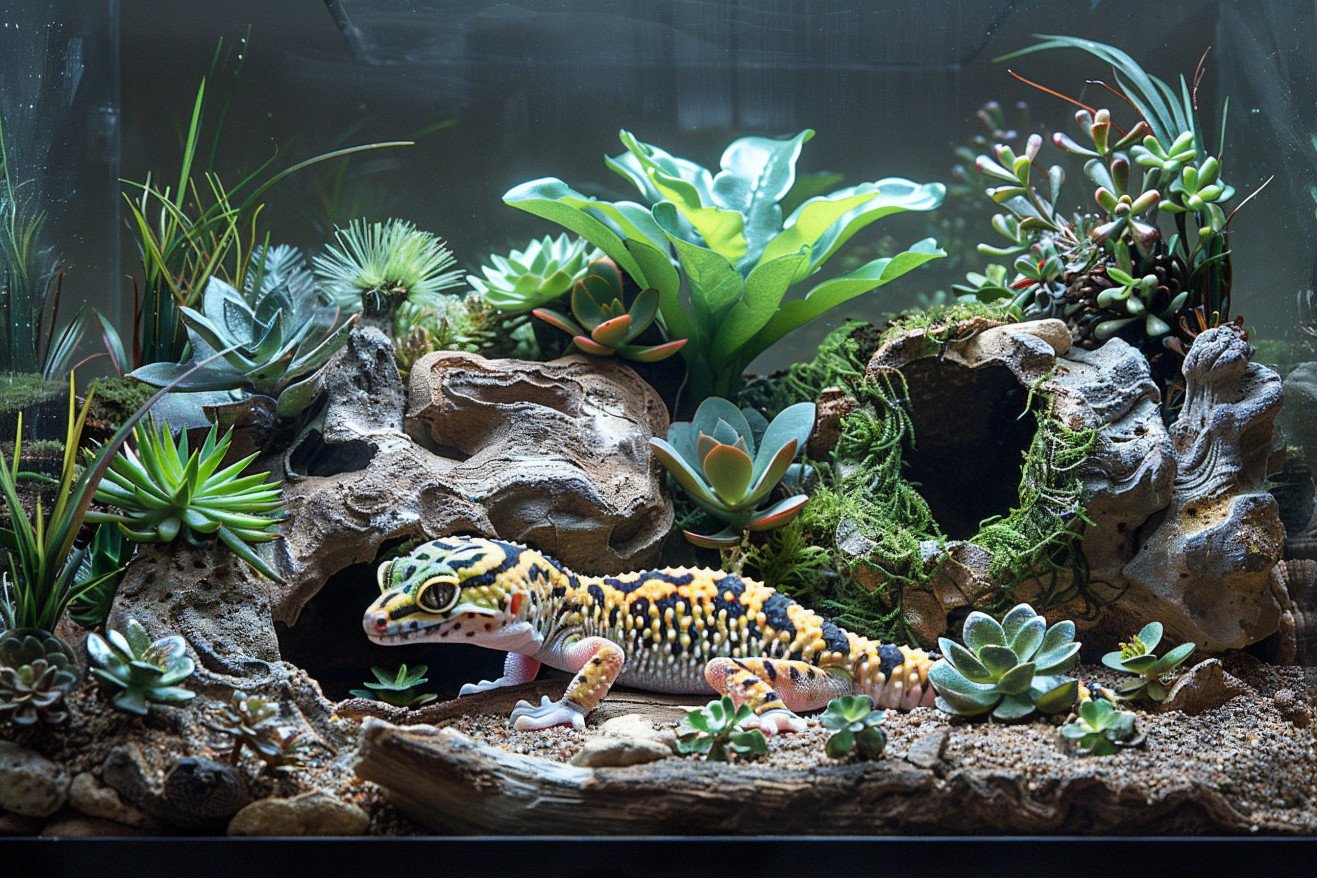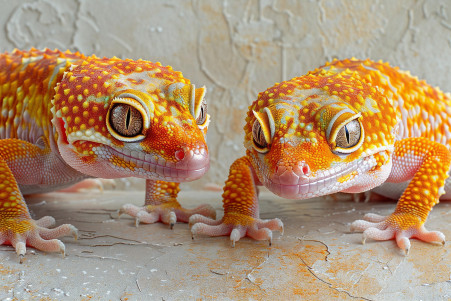Can Leopard Geckos Live Together? What the Research Says
18 April 2024 • Updated 16 April 2024

This is a common question among leopard gecko owners, but there are several important things to know about their housing and social needs before you decide to keep more than one in the same enclosure. Leopard geckos are solitary animals and are best kept alone. Keeping more than one leopard gecko in the same enclosure, especially if they are males, can result in fighting, injuries, and stress due to territorial disputes and bullying. As a result, it is generally best to keep leopard geckos alone.
In this article, we will review studies by herpetologists and other reptile researchers on the social lives of leopard geckos in the wild and in captivity. We will also consider this information in light of what leopard gecko owners have observed. Together, this information will help you understand the housing needs and potential problems of keeping leopard geckos together. Armed with this knowledge, you can make the best decision about how to house these interesting lizards.
Can leopard geckos live together?
The Perfect Leopard Gecko Tank: Size, Decor, and Environmental Conditions
One of the most important factors in keeping leopard geckos healthy in captivity is providing the right tank setup. As noted by ReptiFiles, adult leopard geckos need a tank that's at least 36" x 18" x 18" and has a minimum of 4.5 square feet of floor space. Tanks can be made of glass, while terrariums and wooden or PVC enclosures are also good options.
Leopard geckos need at least two hides, one of which should be a warm, humid hide and the other a cool, dry hide. In addition to these hides, leopard geckos also need climbing structures and a shallow water bowl. It's also important to create a temperature gradient in the tank, with a basking area that's between 88-92°F and a cooler area that's between 75-85°F, using the right heating and lighting equipment.
Humidity levels are also important to maintain. According to Terrarium Quest, the ideal humidity level for a leopard gecko tank is between 30-40% at the cooler end, while the moist hide can be used to create a more humid environment. This will help ensure the leopard geckos' tank is as close to their natural environment as possible and will help them shed properly.
When the tank is set up to resemble their natural arid environment, leopard geckos can thermoregulate, stay hydrated, and feel safe. Meeting their environmental needs is the first step in ensuring they're healthy and happy. Once you have their tank set up, you can focus on ensuring you're meeting their other important needs.
Leopard Gecko Diet and Nutritional Needs
Leopard geckos are insectivores, so their diet should consist of live insects. According to Zen Habitats, a mix of crickets, mealworms, roaches, and other feeders is best. The number of feedings and types of insects will vary based on the age of the gecko - juveniles should be fed once a day, while adults can be fed once every 5 days.
It's also important to make sure that you "gut load" the insects with the right kinds of food before you feed them to your leopard gecko, as ReptiFiles notes. This will ensure that the insects are as nutritious as possible. In addition, insects should be dusted with calcium and multivitamin supplements. Don't feed your leopard gecko dead, dried, or processed foods, as they won't have the same nutritional value.
You should also keep an eye on your leopard gecko's weight and appetite. According to ReptiFiles, sudden weight loss is a common sign of illness. If your leopard gecko isn't eating or is losing weight, make sure to take them to the vet right away to make sure that there aren't any underlying health problems.
By making sure that your leopard gecko has a healthy, balanced diet and paying attention to their eating habits, you can make sure that they're as healthy as possible. This will also make it easier to address any health problems that come up, which we'll cover in the next section.
Leopard Gecko Health Issues and How to Spot Them
Keeping an eye on your leopard gecko's health is important, as these animals can suffer from a number of different health problems. ReptiFiles recommends that you weigh your gecko regularly, as one of the first signs of illness is often a sudden weight loss. They also note that stress in leopard geckos can be indicated by excessive licking, tail waving, vocalizing, hiding, and closed eyes, as listed by Terrarium Quest.
Some of the most common health issues in leopard geckos are impaction, internal parasites, respiratory infections, shedding problems, tail loss, and metabolic bone disease, according to My Family Vets. If you notice your leopard gecko is showing signs of any of these health problems, such as lethargy, loss of appetite, vomiting, weight loss, and breathing difficulties, it's important to get them to the vet as soon as possible. If you notice any changes in your leopard gecko's behavior or health that concern you, it's always best to get them checked out by a vet.
Knowing what to look for in terms of health issues and keeping an eye on your leopard gecko's health will help you be proactive in making sure they stay healthy. This will help you ensure that you can handle and interact with your gecko in the right way, which we'll cover in the next section.
How to Hold and Interact With Leopard Geckos: Tips for Beginners
As the Leopard Gecko Handling & Body Language Guide explains, you should wait at least 2 weeks before handling a new leopard gecko to give it time to acclimate to its new home. You can then start to acclimate your leopard gecko to you by placing your hand in the tank for a few minutes each evening so it can get used to your smell and presence. When you do start handling your leopard gecko, you should start with 5-minute sessions every other day and then work your way up in terms of both length and frequency.
When you do handle your leopard gecko, make sure to support its body and feet and never pick it up by its tail, which can fall off. Terrarium Quest also explains that leopard geckos use a variety of vocalizations, including clicking, chirping, and barking, as well as body language, including tail wagging, to communicate. When you go to pick up your leopard gecko, move slowly and give it time to adjust, and make sure to make the experience as positive as possible. Because juveniles are more skittish, you should work to tame them more slowly and be sure to pay attention to their body language.
Being aware of and responsive to your leopard gecko's communication and handling preferences is important for fostering a positive relationship with it. If you're patient and attentive, you can help your leopard gecko feel safe and comfortable, which will help ensure its overall health and well-being.
Cohabitation Considerations: Weighing the Pros and Cons
Even though some female leopard geckos can cohabitate, Leopard Gecko Care warns that adding new geckos to an existing enclosure is risky. If you do decide to try cohabitation, they suggest a larger enclosure (30-40 gallons) with more hides and close monitoring of food and waste to make sure all of the geckos are eating and pooping normally.
On the other hand, Go Herping says that male leopard geckos should never be housed together because they are territorial and will fight or stress each other out. That said, it's important to watch the geckos' interactions and be ready to separate them if you notice any signs of aggression or stress.
In the end, as BHB Reptiles points out, the safest and most common way to avoid potential problems that could arise from their solitary nature is to house leopard geckos alone. Knowing the pros and cons, this way owners can decide what the best living situation is for their leopard geckos.
Conclusion: How to Best Care for Your Solitary Leopard Gecko
Leopard geckos are interesting reptiles that are best kept alone in captivity. Proper housing, environmental conditions, diet, and handling are all important for their overall health and well-being. By understanding their solitary nature and specific needs, owners can better decide how to house their leopard geckos.
While cohabitation can work in certain situations, it comes with risks and needs to be closely monitored and done in the right kind of enclosure. In the end, the best way to be a responsible pet owner is to make sure that each leopard gecko is kept in an environment that is best suited to their individual needs.


